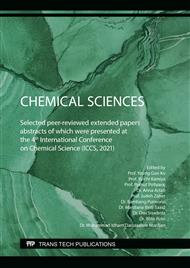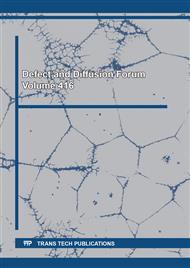[1]
A.A. Putri, S. Kato, N. Kishi, T. Soga, Relevance of precursor molarity in the prepared bismuth oxyiodide films by successive ionic layer adsorption and reaction for solar cell application, J. Sci.: Adv. Mater. Devices 4 (2019), 116–124.
DOI: 10.1016/j.jsamd.2019.01.007
Google Scholar
[2]
Y. Zhang, Q. Pei, J. Liang, T. Feng, X. Zhou, H. Mao, W. Zhang, Y. Hisaeda, X.M. Song, Mesoporous TiO2-based photoanode sensitized by BiOI and investigation of its photovoltaic behavior, Langmuir 31 (2015), 10279–10284.
DOI: 10.1021/acs.langmuir.5b02248
Google Scholar
[3]
A.A. Putri, S. Kato, N. Kishi, T. Soga, Study of annealing temperature effect on the photovoltaic performance of BiOI-based materials, Appl. Sci. 9 (2019), 3342.
DOI: 10.3390/app9163342
Google Scholar
[4]
R.L.Z. Hoye, L.C. Lee, R.C. Kurchin, T.N. Huq, K.H.L. Zhang, M. Sponseller, L. Nienhaus, R.E. Brandt, J. Jean, J.A. Polizzotti, A. Kursumović, M.G. Bawendi, V. Bulović, V. Stevanović, T. Buonassisi, J.L. MacManus-Driscoll, Strongly enhanced photovoltaic performance and defect physics of air-stable bismuth oxyiodide (BiOI), Adv. Mater. 29 (2017), 1–10.
DOI: 10.1002/adma.201702176
Google Scholar
[5]
J. Joo, D. Kim, D.J. Yun, H. Jun, S.W. Rhee, J.S. Lee, K. Yong, S. Kim, S. Jeon, The fabrication of highly uniform ZnO/CdS core/shell structures using a spin-coating-based successive ion layer adsorption and reaction method, Nanotechnology, 21 (2010) 325604.
DOI: 10.1088/0957-4484/21/32/325604
Google Scholar
[6]
R.M.D. Matiur, A.A. Abuelwafa, S. Kato, N. Kishi, T. Soga, A comparative study on optical properties of BiOI, Bi7O9I3 and Bi5O7I materials, Opt. Mater. 111 (2021), 110677.
DOI: 10.1016/j.optmat.2020.110677
Google Scholar
[7]
A.A. Abuelwafa, R.M. Matiur, A.A. Putri, T. Soga, Synthesis, structure, and optical properties of the nanocrystalline bismuth oxyiodide (BiOI) for optoelectronic application, Opt. Mater. 109 (2020), 110413.
DOI: 10.1016/j.optmat.2020.110413
Google Scholar
[8]
A.A. Putri, A.A. Abuelwafa, S. Kato, N. Kishi, T. Soga, A simple spin-assisted SILAR of bismuth oxyiodide films preparation for photovoltaic application, SN Appl. Sci. 2 (2020), 119.
DOI: 10.1007/s42452-019-1913-2
Google Scholar
[9]
Y. Su, K. Li, J. Wang, W. Xie, X. Zhu, C. Wang, Effect of the heating time on the preferred growth of hydroxyapatite crystal prepared by microwave-hydrothermal technique on the defective surface of sprayed coating, Composites, Part B 176 (2019), 107205.
DOI: 10.1016/j.compositesb.2019.107205
Google Scholar
[10]
Y. Park, Y. Na, D. Pradhan, B.K. Min, Y. Sohn, Adsorption and UV/Visible photocatalytic performance of BiOI for methyl orange, Rhodamine B and methylene blue: Ag and Ti-loading effects, CrystEngComm, 16 (2014), 3155–3167.
DOI: 10.1039/c3ce42654h
Google Scholar
[11]
J. Cao, B. Xu, H. Lin, B. Luo, S. Chen, Novel heterostructured Bi2S3/BiOI photocatalyst: Facile preparation, characterization and visible-light photocatalytic performance, Dalton Trans. 41 (2012), 11482–11490.
DOI: 10.1039/c2dt30883e
Google Scholar
[12]
M. Long, P. Hu, H. Wu, Y. Chen, B. Tan, W. Cai, Understanding the composition and electronic structure-dependent photocatalytic performance of bismuth oxyiodides, J. Mater. Chem. A 3 (2015), 5592–5598.
DOI: 10.1039/c4ta06134a
Google Scholar
[13]
W. Fan, H. Li, F. Zhao, X. Xiao, Y. Huang, H. Ji, Y. Tong, Boosting the photocatalytic performance of (001) BiOI: enhancing donor density and separation efficiency of photogenerated electrons and holes, Chem. Commun. 52 (2016), 5316–5319.
DOI: 10.1039/c6cc00903d
Google Scholar
[14]
M. Fang, H. Jia, W. He, Y. Lei, L. Zhang, Z. Zheng, Construction of flexible photoelectrochemical solar cells based on ordered nanostructural BiOI/Bi2S3 heterojunction films, Phys. Chem. Chem. Phys. 17 (2015), 13531–13538.
DOI: 10.1039/c4cp05749j
Google Scholar
[15]
A.A. Putri, A.A. Abuelwafa, S. Kato, N. Kishi, T. Soga, Effect of TiOx and TiO2 layer on the photovoltaic property of BiOI films, Key Eng. Mater. 884 (2021), 372–378.
DOI: 10.4028/www.scientific.net/kem.884.372
Google Scholar
[16]
K. Wang, F. Jia, Z. Zheng, L. Zhang, Crossed BiOI flake array solar cells, Electrochem. Commun. 12 (2010), 1764–1767.
DOI: 10.1016/j.elecom.2010.10.017
Google Scholar
[17]
Y. Liu, J. Xu, L. Wang, H. Zhang, P. Xu, X. Duan, H. Sun, S. Wang, Three-dimensional BiOI/BiOX (X = Cl or Br) nanohybrids for enhanced visible-light photocatalytic activity, Nanomaterials 7 (2017), 64.
DOI: 10.3390/nano7030064
Google Scholar
[18]
Y. Wang, K. Deng, L. Zhang, Visible light photocatalysis of BiOI and its photocatalytic activity enhancement by in situ ionic liquid modification, J. Phys. Chem. C 115 (2011), 14300–14308.
DOI: 10.1021/jp2042069
Google Scholar
[19]
J. Hou, K. Jiang, M. Shen, R. Wei, X. Wu, F. Idrees, C. Cao, Micro and nano hierarchical structures of BiOI/activated carbon for efficient visible-light-photocatalytic reactions, Sci. Rep. 7 (2017), 11665.
DOI: 10.1038/s41598-017-12266-x
Google Scholar
[20]
R.M. Matiur, A.A. Abuelwafa, M.A.A. Noman, S. Kato, N. Kishi, T. Soga, Electrochemical impedance spectroscopy characterization of a bismuth oxyiodide (BiOI) electrochemical cell in terms of various morphologies, J. Electron. Mater. 50 (2021), 4058–4065.
DOI: 10.1007/s11664-021-08917-5
Google Scholar



